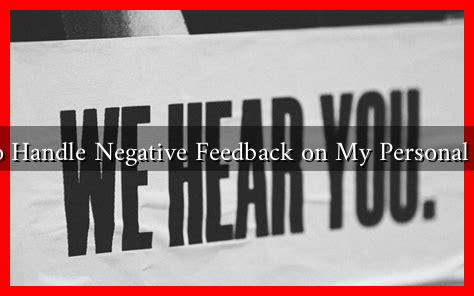-
Table of Contents
- How to Handle Negative Feedback on My Personal Brand?
- Understanding the Nature of Negative Feedback
- Strategies for Responding to Negative Feedback
- 1. Stay Calm and Objective
- 2. Analyze the Feedback
- 3. Respond Professionally
- 4. Take Action
- 5. Monitor Your Online Presence
- Case Studies: Brands That Turned Negativity into Opportunity
- Conclusion
How to Handle Negative Feedback on My Personal Brand?
In today’s digital age, personal branding is more important than ever. Whether you’re an entrepreneur, a freelancer, or a corporate professional, how you present yourself online can significantly impact your career. However, with visibility comes scrutiny, and negative feedback can be a daunting challenge. This article explores effective strategies for handling negative feedback on your personal brand, ensuring that you can turn criticism into an opportunity for growth.
Understanding the Nature of Negative Feedback
Before diving into strategies for handling negative feedback, it’s essential to understand its nature. Negative feedback can stem from various sources, including:
- Customer Reviews: Unfavorable comments on platforms like Yelp or Google Reviews.
- Social Media: Criticism on platforms like Twitter, Facebook, or Instagram.
- Professional Networks: Negative remarks on LinkedIn or industry forums.
- Personal Interactions: Direct feedback from colleagues or clients.
Recognizing the source of the feedback can help you tailor your response effectively.
Strategies for Responding to Negative Feedback
Handling negative feedback requires a thoughtful approach. Here are some strategies to consider:
1. Stay Calm and Objective
When faced with negative feedback, your initial reaction may be emotional. However, it’s crucial to remain calm and assess the situation objectively. Take a moment to breathe and reflect on the feedback before responding. This will help you avoid impulsive reactions that could further damage your brand.
2. Analyze the Feedback
Not all negative feedback is created equal. Some may be constructive, while others may be baseless. Consider the following:
- Is the feedback specific? Constructive criticism often includes specific examples.
- Is it from a credible source? Evaluate the credibility of the person providing the feedback.
- Is there a pattern? If multiple people are giving similar feedback, it may warrant further investigation.
By analyzing the feedback, you can determine whether it’s worth addressing or if it should be disregarded.
3. Respond Professionally
When you decide to respond, do so professionally. Acknowledge the feedback and express gratitude for the input. For example:
“Thank you for your feedback. I appreciate your perspective and will take it into consideration as I continue to develop my brand.”
This approach shows that you value others’ opinions, which can enhance your reputation.
4. Take Action
If the feedback is constructive, consider implementing changes based on the suggestions. This not only improves your brand but also demonstrates your commitment to growth. For instance, if clients mention a lack of communication, you might establish a more robust communication strategy.
5. Monitor Your Online Presence
Regularly monitor your online presence to catch negative feedback early. Tools like Google Alerts or social media monitoring platforms can help you stay informed about what people are saying about you. This proactive approach allows you to address issues before they escalate.
Case Studies: Brands That Turned Negativity into Opportunity
Several brands have successfully navigated negative feedback, turning it into a positive outcome:
- United Airlines: After a widely publicized incident involving passenger removal, United Airlines revamped its customer service policies and improved communication strategies, ultimately restoring its brand image.
- Starbucks: Following backlash over racial bias incidents, Starbucks closed its stores for a day to conduct racial bias training, demonstrating accountability and commitment to change.
These examples illustrate that negative feedback, when handled correctly, can lead to significant improvements and a stronger brand reputation.
Conclusion
Negative feedback is an inevitable part of building a personal brand. However, by staying calm, analyzing the feedback, responding professionally, taking action, and monitoring your online presence, you can turn criticism into an opportunity for growth. Remember, how you handle negative feedback can define your brand just as much as your achievements. Embrace the challenge, learn from it, and continue to evolve your personal brand.
For further reading on personal branding and handling feedback, consider visiting Forbes.

